In our current digital marketing landscape where content is king, marketers are pushed to create and churn out content faster than ever. This is especially true in B2B marketing, where 91% say that they use content marketing as their primary strategy to reach their audience.
However, not everyone has the time, resources, and manpower to create content consistently. Not to mention, the sheer amount of creativity and new ideas that is needed to push out fresh and engaging content each time.
This is why to make sure that the content they do create is efficiently utilized, B2B marketers are turning into content repurposing as a part of their content marketing strategy. But before we dive into examples of how to do B2B content repurposing, let’s take a look first at what it is and why you should do it.
What Is B2B Content Repurposing Strategy?
Content repurposing, to put it in simple terms, is a marketing strategy where you use an existing content you have and adapt or recreate it into a different format.
For example, you hosted a webinar with your B2B influencers. To repurpose it, you can turn that webinar into a blog post, or use the data from it into an infographic. That way, you’ll maximize the investment you made when you created the webinar by transforming it into different content formats.
It’s a great way to meet the demand for content without sacrificing quality.
What Are The Benefits of B2B Content Repurposing?
It saves time and money
This is perhaps the most obvious benefit of content repurposing. Just think of how much time and effort it takes to produce one video content from scratch. By repurposing your content, you’ll save so much time and resources. It’s an efficient way to meet the growing demand for content.
It keeps your content calendar full
Creating new content over and over is a huge challenge, even to the most creative people out there. After all, no one has endless ideas and inspiration to create fresh and original content at all times. By repurposing your content, you won’t need to come up with new ideas every time. Instead, you can maximize your existing content by using them in different ways.
It keeps your content consistent and high quality
Since you already put in the hard work of creating great content to begin with, you’ll ensure that when you repurpose that content, it will be of great quality as well. It also avoids the issue of creating new but uninspiring content just to have something to post.
It reaches new audiences
Even if you created a great piece of content, it's meaningless if it doesn’t reach your audience. By repurposing your content, you’ll have a higher chance of increasing its visibility as well as reaching your audience.
Your audience preference is also a factor here. For example, your audience might have ignored your podcast since it’s not their preferred medium. But when you repurposed that podcast into a blog post, a format they preferred, he or she is now more likely to read it.
It also gives your content a second chance of getting seen, especially by your audience that might have missed it when you first posted it.
It improves your SEO
Another benefit is that having multiple content online will help in boosting your SEO. By having multiple content that talks about the same topic or use the same keyword, you’ll gain higher ranking since you will be recognized as a credible source of information about that topic. It also gives you a chance to earn more backlinks since you are producing multiple shareable content.
It increases your brand presence
Raising brand awareness doesn’t mean just adding your company logo or slogan everywhere. By having lots of high-quality and shareable content, the greater your brand presence will be. And content repurposing is the easiest way to make sure that you can push out high-quality content fast.
How To Do B2B Content Repurposing
Now that you know the importance of content repurposing, let’s take a look at some examples of how to implement B2B content repurposing for your brand.
Use blog articles to create videos
According to a study made by Statista in 2021, videos have an audience reach of 92%. Now is definitely the time to prioritize video content in your marketing strategy.
One of the ways to do that is to use your blog articles and turn them into a “how to” video series. This is also a great way to spin your content if your article is data heavy, since by transforming it into a visual medium, you’ll make it more digestible to your audience.
Or transform them into infographics
Alternatively, you can turn your data-heavy blog articles, or your whitepapers, explainer videos and case studies into infographics instead. Just like videos, infographics will make your content more digestible, engaging, and shareable as well.
Turn your blogs into ebooks
You can also compile your existing blog articles that cover a common topic and combine them into an ebook or a guidebook. You can spin this as an all-in-one instructional guide, which will be helpful for your audience since they don’t have to waste time looking for resources all over the internet.
Maximize your webinars
Webinars take a lot of effort and research to do. To make sure that you maximize the webinar even after the event, you can make use of the slide decks and turn them into social media posts. You can also use the data from the webinar and repurpose it as an infographic. You can also use quotes from the webinar and use them as a Twitter or LinkedIn post.
Transform your podcast into blog article (and vice versa)
Not everyone may prefer listening to podcasts. Instead of letting your content sit around, you can transcribe the podcast and turn it into a blog article instead. It’s efficient since you don’t have to come up with new content for the article since you are just transcribing from an existing podcast instead.
Of course, you can also do the reverse as well. Again, this depends on what format your audience prefers. By having your content available in multiple formats, it increases the chance of having your audience see it.
Compile content from your B2B influencers
If you have influencers, you can make use of their content with you. Short videos from them can be compiled into a long video. This can be a promotional video for your social media or a testimonial video on your website. If you had a panel discussion, interview, or event with them, you can chop it into short videos as well.
Consider Your Other Marketing Strategies
While B2B content repurposing is definitely a great content marketing strategy, you shouldn’t neglect your social media marketing, email marketing, and influencer marketing. This is to make sure your strategy is well-rounded and effective. It’s the key to having a strong and trustworthy brand identity, which is important in B2B marketing.
But first, make sure the visual aspects of your brand identity are polished before starting any marketing strategy. This includes your logo design, brand colors, website design, and other visual elements. By doing all of this, you’ll build a strong brand image, which will make it easier for you to come up with a marketing plan and to create content.
Final Thoughts
Creating great content is crucial to succeeding in today’s competitive online world. B2B marketers need to consistently produce engaging and valuable content in order to stand out from the competition.
However, this doesn’t mean that you should spend all your time and energy on coming up with new content every time. By repurposing your existing content, you can effectively reach your audience without spending a huge amount of time or resources.
We hope the tips above helped you in implementing this content repurposing to your B2B marketing strategy.




